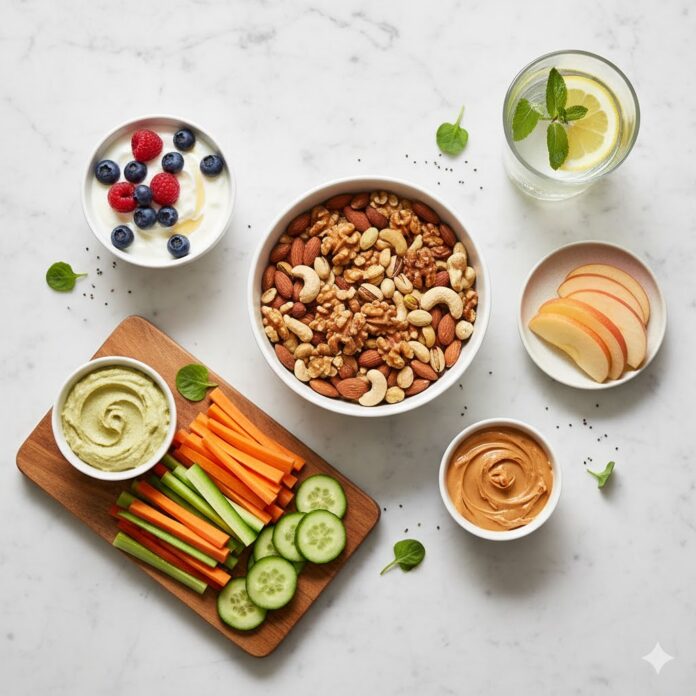Balancing your blood sugar isn’t just for people with diabetes—it’s something everyone can benefit from. When your blood sugar levels stay steady, your body has a more reliable source of energy throughout the day. This means fewer mood swings, less fatigue, and better concentration. On the other hand, when blood sugar spikes and crashes, it can leave you feeling tired, hungry, and unfocused.
The good news is that small changes, like choosing the right snacks, can make a big impact. Healthy snacks that combine protein, fiber, and healthy fats can help you avoid sudden drops in energy and keep cravings under control. In this post, I’ll share the best snacks for keeping blood sugar stable, how to pick the right ingredients, and simple, practical tips you can start using today to support steady energy and better health.
Why Snacking Smart Matters for Blood Sugar
Your body converts the carbohydrates you eat into glucose, which is the main source of energy for your cells. When this process happens too quickly—such as after eating sugary or refined foods—your blood sugar can spike. Soon after, it often drops sharply, leading to fatigue, irritability, or hunger. This “roller coaster effect” can make it harder to stay focused and may even increase your cravings for more sugar.
That’s where smart snacking comes in. Choosing snacks that combine protein, fiber, and healthy fats helps slow digestion and keep glucose release steady. This means your energy lasts longer, and you’re less likely to experience sudden hunger or mood changes. Over time, these habits can even support a healthier metabolism and better overall blood sugar control.
Here’s how smart snacking helps:
- Slows glucose absorption, reducing spikes in blood sugar.
- Keeps you satisfied, so you’re less tempted to overeat later.
- Supports insulin sensitivity, helping your body use glucose more effectively.
- Helps regulate appetite hormones, which control hunger and fullness.
According to the Cleveland Clinic, a satisfying snack should include a mix of protein, fiber, and healthy fats to help maintain stable blood sugar levels. (Cleveland Clinic)
Additionally, Harvard Health explains that foods with a low glycemic index (GI ≤ 55) raise blood sugar more slowly and keep energy levels balanced throughout the day. (Harvard Health)
What to Look for in a Blood Sugar–Friendly Snack

Before we dive into examples, it’s important to understand what makes a snack truly blood sugar–friendly. The right balance of nutrients can help your body process food more efficiently and keep glucose levels steady for hours. When choosing snacks, focus on these key criteria:
- Low to moderate carbohydrates – Choose snacks that don’t overload your system with carbs at once. This helps prevent sudden blood sugar spikes.
- Good amount of fiber – Fiber slows down how fast your body absorbs sugar, keeping you full longer and your energy steady.
- Some protein or healthy fat – These nutrients help balance the effects of carbs and promote a slower, steadier release of glucose.
- Minimal added sugars or refined carbs – Skip sugary drinks, candy, and white bread. They digest too fast and cause quick spikes and crashes.
- Whole, minimally processed ingredients – Foods like nuts, fruits, vegetables, and whole grains retain their nutrients and fiber, making them gentler on your blood sugar.
When you combine these features, you create snacks that digest more slowly and provide lasting energy. This steady release of fuel helps prevent sharp rises in blood sugar and sudden drops later on. According to Medical News Today, choosing snacks that are rich in protein, fiber, and healthy fats is one of the best ways to support balanced blood sugar levels throughout the day. (Medical News Today)
Top Snack Ideas to Keep Blood Sugar Stable
1. Nuts and Seeds (Almonds, Walnuts, Chia, Flax)
- A handful of unsalted nuts is rich in protein, healthy fats, and fiber. (Cleveland Clinic)
- Seeds like chia or flax can be sprinkled over yogurt or used in puddings to further stabilize blood sugar. (Verywell Health)
- Portion control is important — nuts are calorie-dense.
2. Greek Yogurt with Berries or Nuts
- Plain, unsweetened Greek yogurt is high in protein and lower in carbs. (Health)
- Top with berries (like blueberries, raspberries) for fiber and natural sweetness. (Healthline)
- Add a few nuts or seeds for a better nutrient mix.
3. Hard-Boiled Eggs or Egg Whites
- One large egg has minimal carbs but delivers solid protein. (Healthline)
- Keep eggs boiled ahead of time for a fast, portable snack.
4. Vegetables + Hummus / Nut Butter
- Non-starchy veggies (carrot sticks, celery, cucumber) are low in carbs and high in fiber. (Medical News Today)
- Pair with hummus (made from chickpeas) or nut butter for protein and healthy fat. (WebMD)
5. Roasted Chickpeas or Pulses
- Legumes like chickpeas, black beans, lentils are rich in fiber and protein. (Medical News Today)
- Roasting adds crunch and makes them snackable.
6. Avocado on Whole-Grain Toast
- Avocado offers monounsaturated fat and fiber. (diabetes.org)
- One slice of whole-grain toast (look for intact grains) adds a bit of carbs without causing a spike.
7. Cheese or Cottage Cheese + Fruit or Crackers
- Low-fat cheese or cottage cheese pairs well with a small portion of whole-grain crackers or fruit. (WebMD)
- The protein and fat slow absorption of the carbs in the fruit or crackers.
8. Popcorn (Air-Popped)
- As long as it’s air-popped and lightly seasoned, popcorn is a whole grain snack with fiber. (WebMD)
9. Nuts + Fruit Combo
- Example: apple slices with peanut butter or a few almonds. (Healthline)
- The fruit gives natural carbs and fiber; nut butter adds protein and fat.
10. No-Added-Sugar Packaged Snacks
- Look for bars or snacks labeled “no added sugar” with simple ingredients. (EatingWell)
- Be cautious — always check labels for hidden sugars.
How Much & When?
- Aim for snacks under ~ 200 calories, unless your energy needs are higher. (Cleveland Clinic)
- Try not to go more than 4–5 hours between meals to avoid dips. (Cleveland Clinic)
- Spread your carbohydrate intake moderately across meals and snacks. (City of Hope)
Sample Daily Snack Plan

Here’s how you could space out two or three snacks in a day:
| Time | Snack Example |
|---|---|
| Mid-morning | Greek yogurt + berries |
| Afternoon | Veggies + hummus or a handful of nuts |
| Evening | Apple slices + nut butter or avocado toast |
Adjust portion sizes based on your personal energy needs and blood sugar goals.
Tips to Make It Practical
- Prep ahead: Boil eggs, portion nuts, chop veggies.
- Keep portable options: Nuts or seed mixes, small containers of yogurt.
- Read labels: Avoid added sugars and refined flours.
- Hydrate well: Sometimes thirst feels like hunger.
- Stay consistent: Try to snack at similar times daily to support balance.
What to Avoid
- Sugary snacks or desserts: candy, pastries, soda
- Refined carbs with little fiber: white bread, cookies
- Highly processed snack foods with hidden sugars or trans fats
- Drinks with added sugars (sweetened beverages, energy drinks) (Cleveland Clinic)
Why These Work: The Science Behind It
Understanding why these snacks work can help you make smarter food choices every day. Your body’s blood sugar levels respond differently depending on the type of food you eat, how it’s prepared, and what it’s eaten with.
Foods with a low glycemic index (GI) release glucose more gradually, which helps prevent sudden spikes and drops in blood sugar. This means your energy stays more stable throughout the day, and you’re less likely to feel tired or crave sweets soon after eating. (Harvard Health)
When you combine protein, healthy fats, and fiber in one snack, it slows digestion and blunts glucose peaks. These nutrients work together to delay how fast your stomach empties, giving your body more time to absorb nutrients and keeping hunger in check. (Cleveland Clinic)
In addition, whole, minimally processed foods—like fruits, vegetables, nuts, and legumes—keep their natural nutrient structure, known as the “nutrient matrix.” This helps your body regulate insulin more effectively, making it easier to maintain balanced blood sugar levels. The City of Hope notes that eating foods close to their natural state supports overall metabolic health and can even reduce the risk of developing insulin resistance. (City of Hope)
By understanding these simple principles, you can see how every snack choice has a real impact on your energy, mood, and long-term health.
Precautions & Individual Differences
- These snack ideas are generally safe, but consult your doctor or dietitian if you have special health conditions (diabetes, kidney issues, food allergies).
- Always monitor your blood sugar after trying a new snack to see how you respond.
- Adjust carbohydrate portions if your target levels are strict or personalized.

Conclusion & Your Turn
Choosing the best snacks for keeping blood sugar stable comes down to finding the right balance of nutrients that work together to keep your energy steady. The goal is to combine low-to-moderate carbohydrates with fiber, protein, and healthy fats. This mix slows down how fast your body turns food into glucose, helping you avoid the highs and lows that come with sugary or processed snacks.
For example, nuts are packed with healthy fats and protein, while Greek yogurt with berries offers a good mix of protein and natural fiber from fruit. Roasted chickpeas are rich in both fiber and plant-based protein, making them a crunchy and satisfying choice. Veggies with hummus provide complex carbs, fiber, and healthy fats from olive oil and sesame seeds.
These types of snacks do more than just prevent sugar spikes—they also help control hunger, improve focus, and support long-term heart and metabolic health. By choosing snacks made from whole, natural ingredients, you give your body the steady fuel it needs to stay active, alert, and balanced throughout the day.
Now, I’d love to hear from you:
- What’s your favorite go-to snack right now?
- Did you try any of the ideas above — and how did your body respond?
Share your experience or questions in the comments. Let’s build a community of smart snacking!



